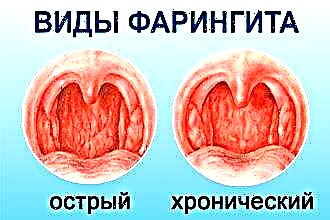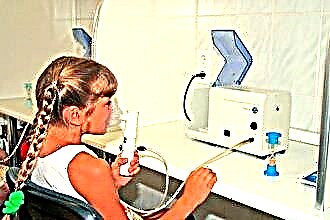If a child is worried about a sore throat, this may be a sign of inflammation of the pharyngeal mucosa - pharyngitis. In order to choose the right treatment for the patient, it is necessary to understand what type of inflammatory lesion is in question. For example, if the disease has arisen acutely and is caused by a bacterial agent, antibiotics will be required, and in case of allergic pharyngitis, anti-allergic drugs are needed. It is also important to know how the symptoms are classified and the treatment of chronic pharyngitis in children depends on the type of pathological process.
The term "pharyngitis" refers to inflammation of the pharyngeal mucosa.
In order to formulate a diagnosis, this definition alone is not enough - it is necessary to indicate the specifying characteristics. What can they be? First of all, attention is paid to the type of course of the pathological process - pharyngitis can proceed in the form:
- sharp;

- chronic.
The nature of the inflammation also matters; in acute course, the most common:
- catarrhal;
- purulent;
- fibrinous.
Chronic pharyngitis is divided as:
- Catarrhal.
- Hypertrophic (hyperplastic).
- Atrophic.
- Mixed.
All types of the disease, according to the type of course and the nature of the inflammation, have features that can be identified by interviewing the patient and examining the mucous membrane of the pharynx (pharyngoscopy).
Acute pharyngitis in children, with proper treatment, most often has a favorable prognosis.
Acute inflammation can result in recovery and is considered more favorable than the chronic form of the inflammatory process, since its outcome is the restoration of the pharyngeal mucosa without scarring. With chronic inflammation of the pharynx, it changes irreversibly, and pharyngitis cannot be completely cured.
Infectious inflammation
 In most cases, children suffer acute infectious pharyngitis - this means that the pathological process in the pharynx area arose as a result of the penetration of infection from the outside or the activation of their own pathogenic flora. The disease can be caused by:
In most cases, children suffer acute infectious pharyngitis - this means that the pathological process in the pharynx area arose as a result of the penetration of infection from the outside or the activation of their own pathogenic flora. The disease can be caused by:
- viruses (respiratory group, herpes group);
- bacteria (streptococci, staphylococci, neisseria);
- mushrooms (genus Candida, Aspergillus).
It is believed that viruses are of the greatest importance for the development of pharyngeal pathology in childhood. The respiratory group of viral pathogens includes influenza viruses, parainfluenza, rhinoviruses, adenoviruses. Infection with beta-hemolytic streptococcus is also common. Fungal pharyngitis (pharyngomycosis) is usually a consequence of immunodeficiency, prolonged treatment with antibacterial drugs.
Viral pharyngitis occurs acutely, symptoms of pharyngeal lesions are combined with rhinitis, tracheitis, tonsillitis, laryngitis. The child does not suffer an isolated inflammation of the pharynx, but ARVI - an acute respiratory viral infection. Sore throat is more often moderate, observed simultaneously with intoxication syndrome of varying severity (general malaise, fever).
If the causative agent of the disease is the herpes group virus, a red or yellowish bubble rash appears in the pharynx; there may be serous exudate inside the vesicles.
Herpes pharyngitis in children is often combined with damage to the oral cavity and is accompanied by severe fever and severe pain due to the destruction of bubbles and the formation of ulcers on the surface of the affected mucous membrane.
Bacterial streptococcal streptococcal pharyngitis in children usually occurs with simultaneous damage to the tonsils. At the same time, the mucous membrane of the nose can be dry, without abundant serous discharge - this sign helps to distinguish bacterial pharyngitis from SARS. With gonococcal pharyngitis in children, eye damage often also occurs - redness, purulent discharge, lacrimation. The mucous membrane with a bacterial infection turns red, swells, covered with mucus and pus. Separately, it is worth talking about diphtheria of the oropharynx - the process is characterized by the formation of gray-yellow films, which are hardly separated from the underlying surface.
Pharyngomycosis in children can be isolated or widespread (with damage to the oral cavity). The leading symptom is the formation of plaque on the reddened mucous membrane of the pharynx. Pathological overlays have a cheesy consistency, they are easy to remove; such attempts do not cause bleeding and ulceration. In the atypical form, the plaque is dense, it is difficult to remove it.
Non-infectious inflammation
Non-infectious is understood as inflammation that develops as a result of exposure to non-infectious factors:
- trauma;
- allergen.
Allergens are food products, as well as substances sprayed into the air. Trauma can be thermal, chemical, mechanical. At the same time, the likelihood of an infection and the start of an infectious and inflammatory process cannot be ruled out - especially if the integrity of the pharyngeal mucosa is violated during trauma. The main manifestations are sore throat, impaired swallowing, salivation.
Unfortunately, traumatogenic inflammation of the pharynx in children is not uncommon. Its occurrence is most often due to domestic negligence and an increased interest of a small child in the surrounding objects. In this case, damage to the pharynx, although it occurs accidentally, can be very difficult. An example is chemical burns as a result of the use of a chemically aggressive liquid (vinegar essence, household cleaner). Injury to the contact surface is not the only consequence of a burn; absorption of toxins leads to systemic intoxication, impaired renal and liver function.
Allergic pharyngitis in children is rarely isolated - at the same time rhinitis, laryngitis, tracheitis of allergic etiology are observed.
Allergic inflammation of the pharynx can be combined with bronchial asthma. The patient is worried about discomfort in the throat, itching in the nasopharynx, coughing, runny nose. Some children may have an increase in body temperature.
Chronic inflammation
In chronic inflammation of the pharynx, it is constantly pathologically altered. This is expressed in symptoms such as:
- redness (hyperemia), swelling;
- discomfort, foreign body sensation;
- soreness, increased pain during an exacerbation.
With catarrhal chronic inflammation, hyperemia and edema predominate, with atrophic mucous membrane dry, pale, covered with viscous mucus that dries up in the form of crusts. Atrophy can be the result of other types of chronic inflammation. With hypertrophic pharyngitis, the mucous membrane thickens, and its glands actively produce mucous secretions; the lymphoid tissue of the pharynx also undergoes hypertrophy.
Treatment principles
If a child has pharyngitis, you need to find out its etiology - the tactics of treatment depend on this. Acute processes require:
- Eliminate the provoking agent.

- Relieve painful symptoms.
- Create conditions for the restoration of the mucous membrane and the body as a whole.
When inflammation is chronic, all factors that may aggravate the severity of the course should be eliminated. The goal of therapy is to prevent exacerbations and deterioration of the patient's condition. It is impossible to completely cure chronic pharyngitis in children, however, if the foci of chronic infection are sanitized, a proper course of treatment is carried out (physiotherapy, antiseptics, remedies that eliminate dryness, etc.), you can achieve a stable remission (no symptoms), and reduce the risk of complications.
For this, first of all, the regime is used: diet, stay in bed during a fever, decrease in voice load, exclusion of food and drinks that can thermally or mechanically irritate the pharyngeal mucosa. The onset of symptoms can be associated with hypothermia, inhalation of dry air and chemical irritants, dust - the child's contact with adverse factors should be prevented.
At home, optimization of the parameters of the microclimate of the room where the child is constantly located (humidity, temperature, air velocity) is shown, gargling for hygienic and therapeutic purposes. Solutions for the procedure and the frequency of treatment of the oropharynx are prescribed by the doctor (herbal infusions, saline, soda solution). With traumatic pharyngitis, you need to stop contact with the traumatogenic factor, assess the degree of damage and the possibility of providing emergency care, and deliver the child to a medical facility.
With bacterial and fungal pharyngitis, etiotropic therapy (antibacterial, antifungal drugs) is used, with viral - symptomatic therapy (except for lesions associated with infection with herpes viruses).
If we are talking about allergic pharyngitis, it is necessary to treat the disease, adhering to the principles of elimination (removal) of allergens. Parents should be informed about the child's tendency to allergic reactions to those people who are constantly near the patient - close relatives, educators, teachers. Care must also be taken to ensure that medications that relieve symptoms (usually antihistamines) are always available for immediate use. If the allergen is accidentally swallowed or inhaled, it is advisable to rinse the mouth with clean water, saline (if the child already knows how to do this).





